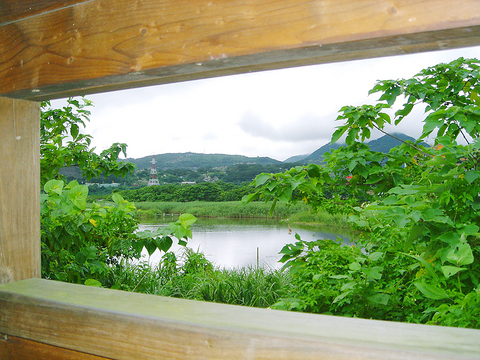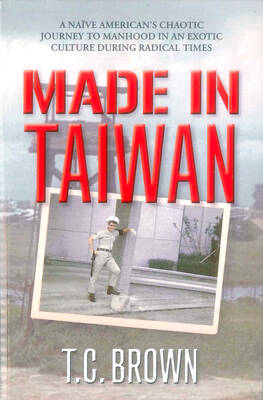Taipei has a vibrant cultural heart but little in the way of lungs, which is why the green expanse of Guandu Nature Park (關渡自然公園) is such a treasure.
An internationally recognized birding area, the park is home to over 830 species of animals, including 229 varieties of fowl.
Joining the flora and fauna this month are six installations from international artists, who have used natural materials to build their works and thereby focus attention on the environment.

PHOTO: JULES QUARTLY, TAIPEI TIMES
This is laudable, of course, and the 2006 Guandu International Outdoor Sculpture Festival, which opened a few weeks ago, provides a convenient hook for a day out to see one of the city's few natural hot spots.
If it's a weekend trip, try and beat the crowd by arriving at the Guandu Nature center in the morning. There's plenty to see in the exhibition and research halls, and the information will provide insight for what is to follow.
The 57-hectare nature park is in a low-lying part of the Taipei Basin, at the confluence of the Keelung and Danshui rivers. The mixture of salt and fresh water makes the area incredibly diverse from an ecological point of view. And this is what attracts the large variety of animals, plants and aquatic creatures.
Having come to terms with the dynamics of wetland eco-systems and learned to differentiate red mangrove from mango, it's time to move on and explore the outdoor observation area; take a trail through the park and check out twitchers in the bird-watching area.
The installations may be a tad disappointing if you're expecting a bold statement. For instance, US artist Jane Ingrame Allen's Nests for Humans are made from fallen branches and are similar to shelters that have been abandoned by picnickers elsewhere.
"These human-sized nests are for people to enter and rest there a while to think about man's relationship to nature and the wonder of a bird's creation," the artist says in a statement about her work.
Japan's Rikuo Ueda made a wind machine of paper and natural debris; while Yimuko Yamazaki floated a raft of soil onto a pond to find out what grows on it.
Having contemplated nature in the abstract it's time to get on your bike and tour the riverside bike trails. A shop nearby on Zhixing Road rents bicycles at around NT$50 per hour.
Take a deep breath and enjoy a trip to Guandu. It's easy to get to on the MRT and a pleasant change from the concrete jungle.
Guandu day out:
Where: Guandu Nature Park, 55, Guandu Rd, Beitou Dist, Taipei (台北市北投區關渡路55號).
Opening hours: March to October open 9am to 5pm on weekdays, 9am to 6pm on weekends. November to February, 9am to 5pm on weekdays, 9am to 5:30pm on weekends. The park is closed on Mondays.
Telephone: (02) 2858-7417.
On the Net: For a detailed map visit www.gd-park.org.tw/en/e1.htm
Pedal power: Chiang Hsian-chin (江憲欽) Bikes, 206 Zhixing Rd, Beitou District, Taipei (台北市北投區知行路206號). Call (02) 2858-7046.
On a prayer: Guandu Temple (關渡宮), 360, Zhixing Rd, Taipei (台北市北投區知行路360號). Call (02) 2858 1281.

Aug. 25 to Aug. 31 Although Mr. Lin (林) had been married to his Japanese wife for a decade, their union was never legally recognized — and even their daughter was officially deemed illegitimate. During the first half of Japanese rule in Taiwan, only marriages between Japanese men and Taiwanese women were valid, unless the Taiwanese husband formally joined a Japanese household. In 1920, Lin took his frustrations directly to the Ministry of Home Affairs: “Since Japan took possession of Taiwan, we have obeyed the government’s directives and committed ourselves to breaking old Qing-era customs. Yet ... our marriages remain unrecognized,

During the Metal Ages, prior to the arrival of the Dutch and Chinese, a great shift took place in indigenous material culture. Glass and agate beads, introduced after 400BC, completely replaced Taiwanese nephrite (jade) as the ornamental materials of choice, anthropologist Liu Jiun-Yu (劉俊昱) of the University of Washington wrote in a 2023 article. He added of the island’s modern indigenous peoples: “They are the descendants of prehistoric Formosans but have no nephrite-using cultures.” Moderns squint at that dynamic era of trade and cultural change through the mutually supporting lenses of later settler-colonialism and imperial power, which treated the indigenous as

An attempt to promote friendship between Japan and countries in Africa has transformed into a xenophobic row about migration after inaccurate media reports suggested the scheme would lead to a “flood of immigrants.” The controversy erupted after the Japan International Cooperation Agency, or JICA, said this month it had designated four Japanese cities as “Africa hometowns” for partner countries in Africa: Mozambique, Nigeria, Ghana and Tanzania. The program, announced at the end of an international conference on African development in Yokohama, will involve personnel exchanges and events to foster closer ties between the four regional Japanese cities — Imabari, Kisarazu, Sanjo and

By 1971, heroin and opium use among US troops fighting in Vietnam had reached epidemic proportions, with 42 percent of American servicemen saying they’d tried opioids at least once and around 20 percent claiming some level of addiction, according to the US Department of Defense. Though heroin use by US troops has been little discussed in the context of Taiwan, these and other drugs — produced in part by rogue Chinese Nationalist Party (KMT) armies then in Thailand and Myanmar — also spread to US military bases on the island, where soldiers were often stoned or high. American military policeman